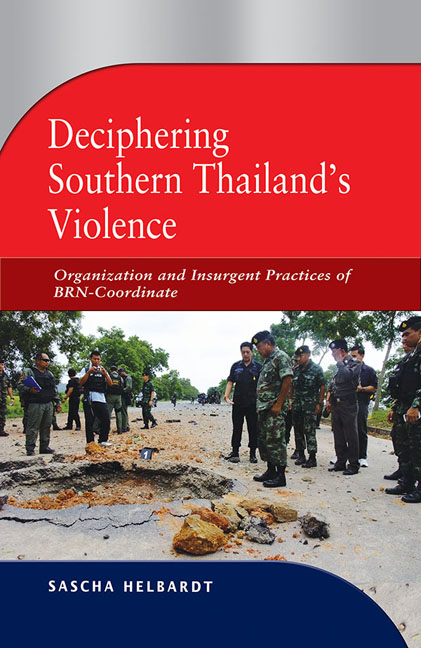Book contents
- Frontmatter
- Dedication
- Contents
- List of Figures
- List of Abbreviations
- Preface and Acknowledgments
- 1 Introduction
- 2 Organizational Aspects of BRN-Coordinate
- 3 Making Insurgents: Recruitment, Training and Control
- 4 Bringing the Actors Back In: Who Are the Insurgents?
- 5 Making Sense of Violence: Power and the Insurgency's Communicative Side
- 6 Conclusion
- References
- Bibliography
- About the Author
3 - Making Insurgents: Recruitment, Training and Control
Published online by Cambridge University Press: 19 May 2017
- Frontmatter
- Dedication
- Contents
- List of Figures
- List of Abbreviations
- Preface and Acknowledgments
- 1 Introduction
- 2 Organizational Aspects of BRN-Coordinate
- 3 Making Insurgents: Recruitment, Training and Control
- 4 Bringing the Actors Back In: Who Are the Insurgents?
- 5 Making Sense of Violence: Power and the Insurgency's Communicative Side
- 6 Conclusion
- References
- Bibliography
- About the Author
Summary
Popular discontent or a “crisis of legitimacy” are often assumed to stand in direct causal relation to the outbreak of insurgencies, regime changes, or revolutionary action. Such explanations are, however, problematic. Rebellious attitudes or preferences for a change in the status quo of a regime are unlikely to translate into collective action in a quasi-automatic fashion without the recruitment of insurgents who are willing to take the mortal risks of fighting an incumbent government. Every dissident who aims to generate collective action has to respond to the following question: what kind of appeal is most promising for encouraging people to join an organization seeking a public good?
Recruitment poses an immense challenge in societies with low capacity for horizontal organization. While some armed groups solve this problem by relying on less committed members motivated by material gratification or are coerced to fight, groups such as the IRA, the Vietcong, LTTE, or BRN-Coordinate, which work under the conditions of secrecy, must adopt a different recruitment strategy. Since clandestine groups are under constant threat of defection and betrayal, they tend to draw on individuals that strongly identify with the organization's objectives.
Accordingly, mobilization, military instruction, and the political indoctrination of members are key factors for the cohesion and success of armed groups. Drawing on Foucault's (1995) concept of subjectivation, Schlichte (2009) argues that armed groups expose their members to a double-edged process, socializing recruits into their symbols and practices.1 On one hand, training turns recruits into mobilized members, who are familiar with the symbolic codes of BRN-Coordinate, helping them to communicate with other members, and making them willing to turn against the ruling order — that is, using violent means and risking their lives. In other words, any cultural values and social institutions that inhibit the use of violence or suggest peaceful solutions to conflict must be overcome. On the other hand, recruits are subjected to a new system of domination within the armed group, namely, a disciplinary apparatus that includes the use of force.
In exploring this process, I will begin by illustrating the contexts in which BRN-Coordinate recruits new members. Following this, I will identify the “cultural repertoires” of agitation, which are used by recruiters, as well as the role of pre-existing social ties for gaining new members.
- Type
- Chapter
- Information
- Deciphering Southern Thailand's ViolenceOrganization and Insurgent Practices of BRN-Coordinate, pp. 90 - 139Publisher: ISEAS–Yusof Ishak InstitutePrint publication year: 2014

